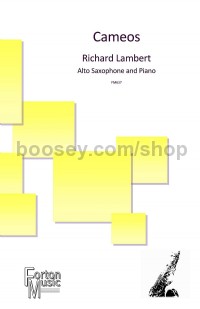Cameos (Alto Saxophone & Piano)
Cameos (Alto Saxophone & Piano)
* Estimated price converted from UK retail price
Abigail’s Jig, op. 10 no. 2j Originally composed for flute and piano in 1980 to celebrate the birth of Abby, the composer’s daughter, this version for alto saxophone was written in 2017. It attempts to capture the atmosphere of an Irish jig as played by a piper, with a harmonically straightforward piano part, which uses a mixture of ‘vamping’ and melodic imitation of the sax part. The introduction is intended to be humorous and rather musically misleading, openly parodying the ‘cowboy’ music of Aaron Copland. Modal harmony helps to create the mood of pseudo-folk music. Cantilena, Op. 11 Cantilena tries to capture a popular flavour, borrowing freely from pop and jazz styles: primary and secondary chords are used in arpeggiated piano figures, as mainstream ballads might do; pedal notes are a feature, especially on the tonic note; and a ‘bluesy’ style emerges in the third main theme. A pseudo-rock style is twice used in the climax section, which acts as a song-like chorus. Cantilena is in the key of Db major overall, but even the introduction uses ‘wrong note’ harmony (notably flattened sevenths) to produce ambiguous tonality. The piece, written in 1987, demonstrates a range of tone colour for the sax across a wide melodic range. Five Short Pieces, Op. 9f This set of pieces was originally composed for flute in 1985, and arranged for sax in 2017. They are elaborate transcriptions of To One, five songs to poems by Christina Rees, which convey the countless moods associated with a relationship.



